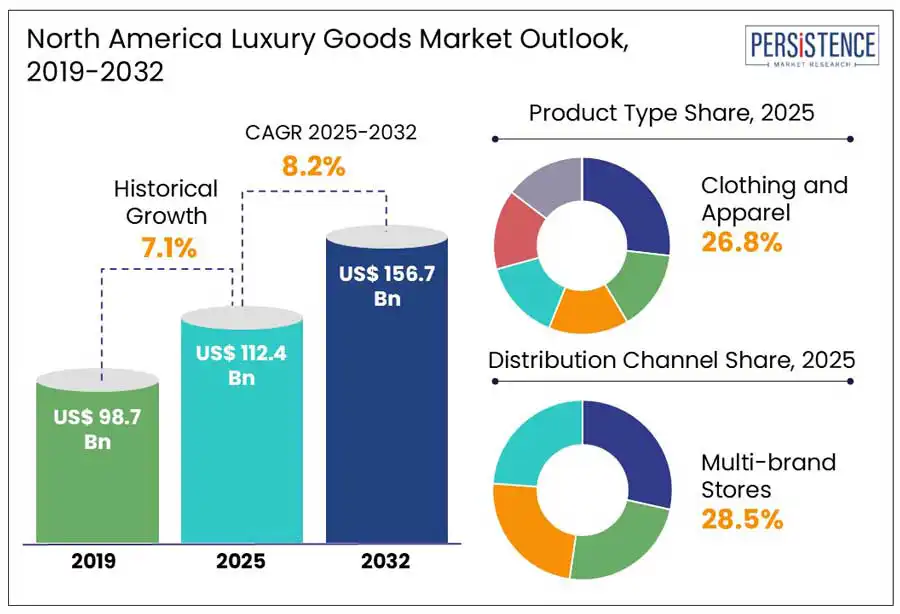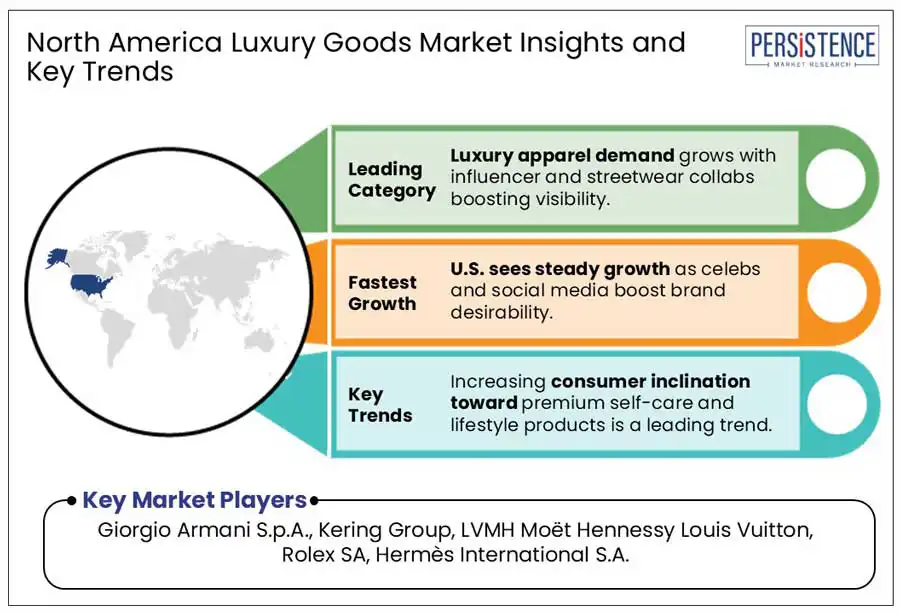Comprehensive Snapshot for North America Luxury Goods Market, Including Country and Segment Analysis in Brief.
Industry: Consumer Goods
Published Date: April-2025
Format: PPT*, PDF, EXCEL
Delivery Timelines: Contact Sales
Number of Pages: 140
Report ID: PMRREP35241
The North America luxury goods market size is projected to rise from US$ 112.4 Bn in 2025 to US$ 156.7 Bn by 2032. It is anticipated to witness a CAGR of 8.2% during the forecast period from 2025 to 2032.
North America has a significantly higher population of fashion-forward, relatively well-off customers who follow the latest trends in personal accessories such as jewelry, watches, purses, and clothing. With the emergence of several social media influencers promoting the newly launched collections of luxury goods brands to attract customers, the fashion industry is poised to witness some major trends in the coming years. Also, North America has a robust network of multi-brand and single-brand stores in shopping centers and airports. This makes it convenient for affluent customers to choose from a wide range of products, right from international to regional luxury brands.

Key Industry Highlights:
|
Market Attribute |
Key Insights |
|
North America Luxury Goods Market Size (2025E) |
US$ 112.4 Bn |
|
Market Value Forecast (2032F) |
US$ 156.7 Bn |
|
Projected Growth (CAGR 2025 to 2032) |
8.2% |
|
Historical Market Growth (CAGR 2019 to 2024) |
7.1% |
The presence of a younger, aspirational demographic and High-Net-Worth Individuals (HNWIs) in North America is anticipated to create a surging demand for luxury goods. The Capgemini World Wealth Report 2024 declared that the region regained its leading position in terms of wealth and HNWI population, significantly contributing to luxury product consumption. This surge in wealth has increased spending on high-end jewelry, watches, and apparel as well as experiential luxury, including gourmet dining and travel.
The emergence of quiet luxury is further projected to boost the North America luxury goods market growth. It is a new trend marked by high craftsmanship and understated elegance, promoted by brands such as Brunello Cucinelli, The Row, and Loro Piana. Inspired by shows such as Succession, brands are focusing on exclusivity and quality over logo-heavy branding. They are also investing huge sums in digital transformation to target millennial and Gen Z customers seeking personalized experiences. As per a study, more than 25% of luxury goods sales in North America were made online in 2023 alone. It was mainly propelled by influencer marketing on Instagram, virtual try-ons, and digital campaigns.
Counterfeiting and resale dilemma is presumed to create limitations in the field of luxury goods across North America. Even though the resale market is increasing at a fast pace, this growth will likely lead to vulnerabilities. Several customers are now shifting toward secondhand product sellers to bypass exorbitant retail pricing. When supply becomes easily accessible, this poses a risk of undervaluing the perception of luxury.
North America is also considered a significant hub for counterfeit products. As per a report by the U.S. Customs and Border Protection, for example, in 2023 alone, it seized more than US$ 2.4 Bn in fake luxury products, with counterfeit watches, jewelry, and handbags dominating the list. This negatively affects consumer trust and brand integrity, mainly as counterfeit products are becoming increasingly complex to detect due to innovations in replica manufacturing.
A key opportunity in North America luxury goods market lies in the growth of circular and sustainable luxury. Modern customers are compelling luxury brands to adapt or risk losing relevance with their deep concerns about the environment and ethical footprint of their purchases.
First Insight and the Wharton School, for example, found in a 2024 report that around 65% of luxury consumers in the U.S. now consider sustainability a significant purchase driver and nearly 73% of Gen Z consumers are willing to pay more for eco-friendly products. This rapid shift will likely create several new opportunities for developments in eco-focused branding, resale platforms, supply chain transparency, and raw materials.
Concierge-level customer experiences and hyper-personalization are likely to be the key trends in North America by 2032. These are estimated to become prevalent as modern customers seek emotionally resonant, personalized experiences rather than just a product. The rising influence of Customer Relationship Management (CRM) technologies, data analytics, and Artificial Intelligence (AI) is predicted to allow brands to track individual behaviors and preferences across physical and digital channels.
As per a 2024 report, in the U.S., around 71% of luxury product customers reported that personalized experiences significantly affected their purchase decisions, up from 59% two years ago. Key brands are hence responding by embracing high-touch, tech-powered clienteling strategies. Hermès, for instance, has already set the benchmark for ultra-exclusive customer engagement with its private viewing salons in San Francisco, Miami, and New York. Affluent customers are invited to these salons to preview upcoming collections.
By product type, the market is segregated into clothing and apparel, footwear, bags, jewelry, and watches. Clothing and apparel segment is expected to hold a share of about 26.8% in 2025, according to the Persistence Market Research report. Limited drops and rapid turnover of collections are anticipated to propel this segment by augmenting frequent purchases. High-end clothing brands such as Off-White, Louis Vuitton, and Balenciaga, for example, often release capsule collaborations and collections that develop a sense of exclusivity and urgency. This fast-paced cycle keeps customers spending and engaged regularly.
Bags, specifically handbags, are poised to exhibit a steady growth rate in the foreseeable future. These are mainly considered functional fashion essentials, investment pieces, and status symbols. The high appreciation and resale value related to iconic luxury handbags position these as both financial assets and fashion statements. The Hermès Birkin, for example, has successfully outperformed conventional investment classes, including stocks and gold, over the past decade. A 2023 report mentioned that in North America’s resale market, Hermès handbags were able to hold onto up to 130% of their retail value, thereby boosting demand.
Based on distribution channel, the market is divided into single-branded stores, multi-brand stores, and online stores. Among these, multi-brand stores are predicted to generate around 28.5% of the North America luxury goods market share in 2025. This is attributed to their ability to provide curated cross-brand discovery and variety under one roof. Multi-brand retailers such as SSENSE, Neiman Marcus, and Fifth Avenue offer a comparative, broader shopping experience catering to affluent customers who prefer exploring seasonal collections across various labels.
Online stores, on the other hand, are speculated to showcase a considerable CAGR through 2032 due to their ability to cater to high-income, tech-savvy customers who emphasize personalized digital experiences, exclusivity, and convenience. According to a recent study, in North America, online luxury sales surged by 16% year-over-year in 2024. This was propelled by digitally fluent Gen Z and millennial customers.

The U.S. is presumed to account for a share of nearly 57.3% in 2025. It is projected to be driven by California, which is a key hub for luxury products, specifically in cities such as San Francisco and Los Angeles. Luxury home décor products are showcasing a high demand in Los Angeles as prices of high-tier homes surged around 4% year-over-year in 2024. New York is also estimated to remain a significant market for luxury goods due to its robust position in the fashion industry.
For instance, Goyard, a France-based luxury brand announced in May 2025 its plans to open the first Madison Avenue store. In March 2025, Dolce & Gabbana, the popular Italy-based brand, on the other hand, opened a 23,000-square-foot flagship store at 695 Madison Avenue. These expansions from international luxury brands highlight New York’s constant appeal to affluent consumers.
Demand for premium athleisure and casual luxury apparel is anticipated to rise steadily across Canada through 2032. This is attributed to the increasing willingness of affluent customers to invest in durable, high-quality products that provide both style and functionality. Women are expected to represent one of the most prominent consumer bases in the country’s premium athleisure segment. Stylish tops, sports bras, and leggings have already become staples for everyday casual wear. The trend points toward increasing preference for clothing transitions from fitness activities to social settings.
For instance, Lululemon Athletica, based in Vancouver, is a leading player in the field of premium athleisure. It aims to surge its revenue to US$ 12.5 Bn by 2026 from US$ 8 Bn in 2022. It will likely focus on augmenting its presence into categories such as tennis, weightlifting, and running beyond its yoga leggings niche. It plans to invest further in men's footwear and clothing to quadruple its international business and double digital sales.
The North America luxury goods market is highly competitive with the presence of various multinational and domestic companies. Key companies are focusing on strategies such as new product launches, mergers and acquisitions, collaborations, and geographic expansions to enhance their brand presence among modern customers. A few leading companies are striving to provide an enhanced shopping experience to their potential customers by introducing new boutiques and outlets with skilled staff.
|
Report Attribute |
Details |
|
Historical Data/Actuals |
2019 - 2024 |
|
Forecast Period |
2025 - 2032 |
|
Market Analysis Units |
Value: US$ Bn/Mn, Volume: As Applicable |
|
Geographical Coverage |
|
|
Segmental Coverage |
|
|
Competitive Analysis |
|
|
Report Highlights |
|
|
Customization and Pricing |
Available upon request |
By Product Type
By Distribution Channel
By Country
To know more about delivery timeline for this report Contact Sales

The North America luxury goods market is projected to be valued at US$ 112.4 Bn in 2025.
Increasing demand from HNWIs and the emergence of quiet luxury are the key market drivers.
The North America luxury goods market is poised to witness a CAGR of 8.2% from 2025 to 2032.
Focus of luxury brands on circular fashion and the boom of hyper-personalization trends are the key market opportunities.
Giorgio Armani S.p.A., Kering Group, and Rolex SA are a few key players in the market.